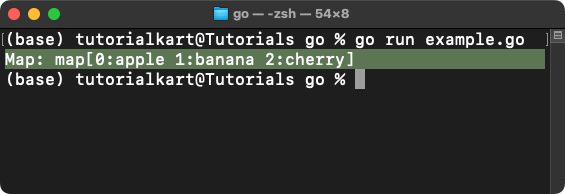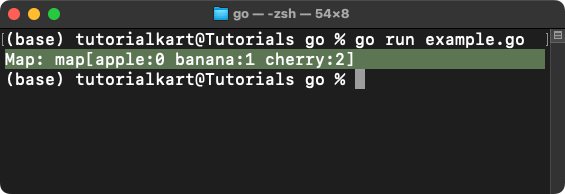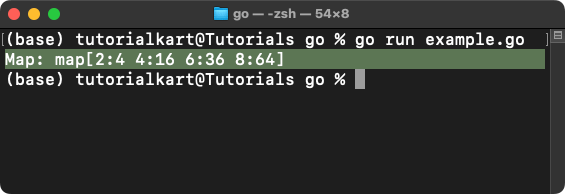Go – Convert Slice to Map
In Go, slices are used for dynamic collections of elements, while maps are key-value pairs that offer fast lookups. Converting a slice to a map involves mapping each element of the slice to a key in the map, based on a specific logic or transformation.
In this tutorial, we will explore how to convert slices to maps in Go using practical examples and detailed explanations.
Steps to Convert Slice to Map
- Initialize a Map: Create an empty map to store the key-value pairs.
- Iterate Through Slice: Use a
forloop to iterate through the slice. - Assign Keys and Values: Define the logic for mapping slice elements to keys and values in the map.
Examples of Converting Slice to Map
1 Convert Slice to Map Using Index as Key
This example demonstrates how to convert a slice to a map using the slice index as the map key:
</>
Copy
package main
import "fmt"
func main() {
// Declare and initialize a slice
slice := []string{"apple", "banana", "cherry"}
// Create an empty map
result := make(map[int]string)
// Convert slice to map
for i, v := range slice {
result[i] = v
}
// Print the resulting map
fmt.Println("Map:", result)
}Explanation
- Declare Slice: The slice
sliceis initialized with values{"apple", "banana", "cherry"}. - Create Map: An empty map
resultis created with integer keys and string values. - Assign Key-Value Pairs: A
forloop iterates through the slice, mapping each index to its corresponding value in the map. - Print Result: The resulting map is printed using
fmt.Println.
Output

2 Convert Slice to Map Using Element as Key
This example demonstrates how to convert a slice to a map using the slice element as the map key:
</>
Copy
package main
import "fmt"
func main() {
// Declare and initialize a slice
slice := []string{"apple", "banana", "cherry"}
// Create an empty map
result := make(map[string]int)
// Convert slice to map
for i, v := range slice {
result[v] = i
}
// Print the resulting map
fmt.Println("Map:", result)
}Explanation
- Declare Slice: The slice
sliceis initialized with values{"apple", "banana", "cherry"}. - Create Map: An empty map
resultis created with string keys and integer values. - Assign Key-Value Pairs: A
forloop iterates through the slice, mapping each element to its index in the map. - Print Result: The resulting map is printed using
fmt.Println.
Output

3 Convert Slice to Map Using Custom Logic
This example demonstrates how to apply custom logic when converting a slice to a map:
</>
Copy
package main
import "fmt"
func main() {
// Declare and initialize a slice
slice := []int{2, 4, 6, 8}
// Create an empty map
result := make(map[int]int)
// Convert slice to map
for _, v := range slice {
result[v] = v * v
}
// Print the resulting map
fmt.Println("Map:", result)
}Explanation
- Declare Slice: The slice
sliceis initialized with values{2, 4, 6, 8}. - Create Map: An empty map
resultis created with integer keys and integer values. - Custom Logic: Each element is mapped to its square as the value in the map.
- Print Result: The resulting map is printed using
fmt.Println.
Output

Points to Remember
- Logic-Driven Keys and Values: Define clear logic for mapping slice elements to keys and values in the map.
- Map Initialization: Always initialize the map using
makebefore populating it. - Dynamic Mapping: You can map slice elements to any type of key-value pairs based on your requirements.
- Memory Independence: The map is independent of the original slice after conversion.
